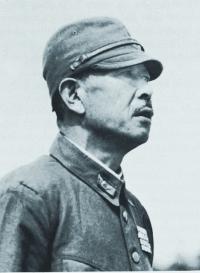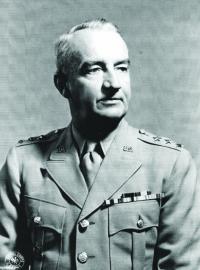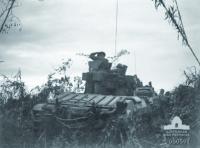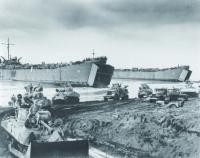
General Hataz Adachi

Lieutenant General Robert Eichelberger

Matilda tanks from the Australian 1st Tank Battalion move up towards the fighting, 17 November 1943.

U.S. Army M4 Sherman tanks and other vehicles disembarking from LSTs onto Noemfoor.

When most people think about the battles fought on Pacific Islands during World War II, the islands are often perceived as relatively small in area. In some cases this is true. Iwo Jima is only eight square miles and Peleliu is only five. Guadalcanal, the largest island in the Solomons is only 2047 square miles, a little less than half the size of the Delmarva Peninsula. New Guinea, on the other hand, is the second largest island in the world, encompassing 303,500 square miles. New Guinea is larger in land area than Germany and Japan combined. ItÙs even bigger than Texas.
Fighting began in January of 1942 and continued until the surrender of General Hataz Adachi on September 13, 1945, almost a month after Japan had announced its surrender on August 15th. When the war began in December of 1941, Japan decided that Southeast Asia should become part of the Greater East Asia Co-Prosperity Sphere. This really meant that Japan would seize and control the oil, rubber and other strategic commodities. New Guinea was also seen as a launching point for the invasion of Australia.
In January of 1943, the Japanese held the north coast with their headquarters at Buna and the Allies, the south coast with their headquarters at Port Moresby. They are separated by a high mountain range running almost the entire length of the island. This is no mere set of foothills. Five of the major peaks exceed 14,000 feet in height. Much of the rest of the island consists of rainforests, wetlands, and mangrove forests.
The Allied commander was General Douglas McArthur who was based in Australia, while the Japanese commander was Lt. General Adachi. The first battles after the Japanese occupied New Guinea were between the Japanese and the Australians, who were defending Port Moresby. The Japanese attacked across the Owen Stanley mountain range in a series of battles which became known as the Kokoda Track campaign or Kokoda Trail campaign. The fighting began in July and did not end until November of 1942. Meeting the Japanese on the Kokoda Track, the vastly outnumbered Australian forces fought a two-month defensive battle, and were pushed back over the track toward Port Moresby over very difficult terrain by the superior Japanese forces. Within 48 km (30 mi) of Port Moresby, 80 percent of the Japanese forces had been wounded, killed or disabled by disease. Despite this, the Japanese pushed on until in sight of Port Moresby. They were then ordered to withdraw so the Imperial Forces could concentrate their resources on the battle for Guadalcanal.
The Japanese forces had successfully invaded and occupied Lae and Salamaua in March 1942, and began the construction of a base and airfield. The invasion was contested by the aircraft carriers Lexington and Yorktown which launched 104 aircraft and sank, or damaged, two-thirds of the Japanese invasion transports. The Japanese then set in motion an invasion of Port Moresby by sea. This was abandoned due to losses suffered by the Japanese in the Battle of the Coral Sea.
On 16 November 1942, Australian and United StatesÙ forces attacked the main Japanese beachheads in New Guinea, at Buna, Sanananda and Gona. Fighting continued until January 22, 1943. Allied intelligence vastly underestimated the number of Japanese defenders and how deeply they were entrenched. Casualties on both sides were extremely high. General Robert H. Eichelberger later compared the casualty ratio to the American Civil War. As a percentage of casualties, killed or wounded in action at Buna exceeded the better-known Battle of Guadalcanal by a margin of three to one.
Allied forces then sought to capture two major Japanese bases, one in the town of Lae, and another one at Salamaua. The campaign to take the Salamaua and Lae area began with the Australian attack on Japanese positions near Mubo, on 22 April 1943. The campaign ended with the fall of Lae on 16 September 1943. While the fall of Lae was clearly a victory for the Allies, and was achieved more quickly and at lower cost than anticipated, a significant proportion of the Japanese garrison had escaped through the Saruwaged Range, to the north of Lae, and would have to be fought again elsewhere.
In September of 1943, the Allies commenced the Huon Peninsula campaign. In five months of hard fighting the Japanese were pushed back from the peninsula. Estimates of Japanese killed range from 5500 to 8000. Allied killed were 283. Disease also proved significant, and during the campaign up to 85 per cent of the Allied personnel were ineffective due to illness at some stage. The Japanese were also feeling the pinch of lack of supplies and ammunition due to increasing Allied control of the sea and air.
The Allies then began the Western New Guinea campaign. The campaign began with Operations Reckless and Persecution, which were amphibious landings by the U.S. I Corps at Hollandia and Aitape on April 22, 1944. Over the next year battles were fought at Wakde, Lone Tree Hill, Morotai, Biak, Noemfoor, and Driniumor River.
By the end of the campaign, the Australians had lost 442 men killed and 1,141 wounded. On top of this, a further 16,203 men were listed as "sickness casualties." More than 9,000 Japanese were killed while 269 were captured during the fighting. Following the end of hostilities in New Guinea, approximately 13,000 Japanese surrendered, with about 14,000 having died of starvation and illness during the entire campaign. Fighting in western New Guinea continued until the end of the war. Japanese casualties in the numerous battles and actions on New Guinea are estimated to have exceeded 35,000 dead.
On a personal note, my father, Lt. Colonel William Collins, U.S. Army, fought in the New Guinea campaign in 1943 and 1944. He caught malaria there and suffered periodic bouts of it until his death at the age of 92. Of all of his experiences in World War II - and he fought in the Pacific as an enlisted man and in Europe as an officer - New Guinea was the one part he refused to discuss.
Special thanks to Wikipedia, the free encyclopedia!
NEXT WEEK: KURSK
«Go back to the previous page.




